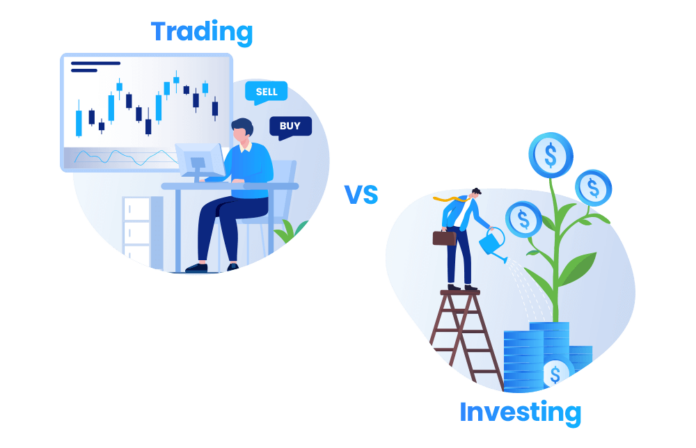Introduction
Trading and investing are two fundamental approaches to growing wealth in financial markets. While both involve buying and selling assets, they differ in terms of strategy, time horizon, and risk management. Understanding these basics is essential for anyone looking to participate in the stock market, cryptocurrency market, or forex trading.
1. Trading vs. Investing
1.1 What is Trading?
Trading refers to the buying and selling of financial assets (stocks, cryptocurrencies, forex, commodities) over a short time frame. Traders aim to capitalize on market fluctuations to make quick profits.
Types of Trading:
- Day Trading: Buying and selling assets within a single trading day.
- Swing Trading: Holding assets for a few days or weeks to take advantage of short-term price movements.
- Scalping: Making multiple small trades to profit from tiny price changes.
- Position Trading: Holding positions for weeks or months based on market trends.
1.2 What is Investing?
Investing is a long-term approach where individuals buy assets with the expectation of gradual appreciation over time. Investors analyze fundamentals and macroeconomic trends rather than short-term price movements.
Types of Investing:
- Value Investing: Buying undervalued assets based on intrinsic value.
- Growth Investing: Investing in companies or assets expected to grow at an above-average rate.
- Dividend Investing: Focusing on stocks that pay regular dividends.
- Index Investing: Buying ETFs or index funds that track market performance.
2. Market Types
- Stock Market: Where shares of publicly traded companies are bought and sold (e.g., NYSE, Nasdaq).
- Forex Market: Global currency exchange market, trading currency pairs like USD/EUR.
- Cryptocurrency Market: Digital assets like Bitcoin, Ethereum, and altcoins.
- Commodities Market: Trading physical assets like gold, oil, and agricultural products.
3. Risk Management
Risk management is essential to prevent significant financial losses. Key techniques include:
- Stop-Loss Orders: Automatically selling an asset when it reaches a predetermined price.
- Position Sizing: Controlling how much capital is allocated to a single trade.
- Diversification: Spreading investments across different assets to reduce risk.
- Hedging: Using derivatives like options or futures to protect against losses.
4. Fundamental vs. Technical Analysis
4.1 Fundamental Analysis (FA)
Fundamental analysis involves evaluating the financial health and future potential of an asset based on factors such as:
- Earnings reports
- Industry trends
- Macroeconomic indicators
- Management team
4.2 Technical Analysis (TA)
Technical analysis focuses on historical price movements and trading volume using charts and indicators:
- Support & Resistance: Price levels where an asset tends to stop moving higher or lower.
- Indicators: Tools like RSI, MACD, and Bollinger Bands help identify trends.
- Chart Patterns: Formations like head and shoulders, triangles, and candlestick patterns.
5. Trading Psychology
Emotional control is critical in trading and investing. Common psychological pitfalls include:
- Fear and Greed: Making impulsive decisions based on emotions.
- FOMO (Fear of Missing Out): Jumping into trades due to hype.
- Overtrading: Taking too many trades, leading to poor decision-making.
6. Tools and Platforms
To engage in trading and investing, you need the right tools:
- Trading Platforms: Binance, Coinbase, Bybit, MetaTrader, ThinkorSwim.
- Charting Software: TradingView, StockCharts.
- News Sources: Bloomberg, CoinDesk, MarketWatch.
- Portfolio Trackers: CoinGecko, Delta, Yahoo Finance.
7. Conclusion
Both trading and investing offer opportunities for financial growth, but they require different strategies, risk tolerances, and time commitments. Understanding the basics of both can help individuals develop a profitable approach that suits their financial goals. Whether short-term trading or long-term investing, education, discipline, and risk management are the keys to success.


